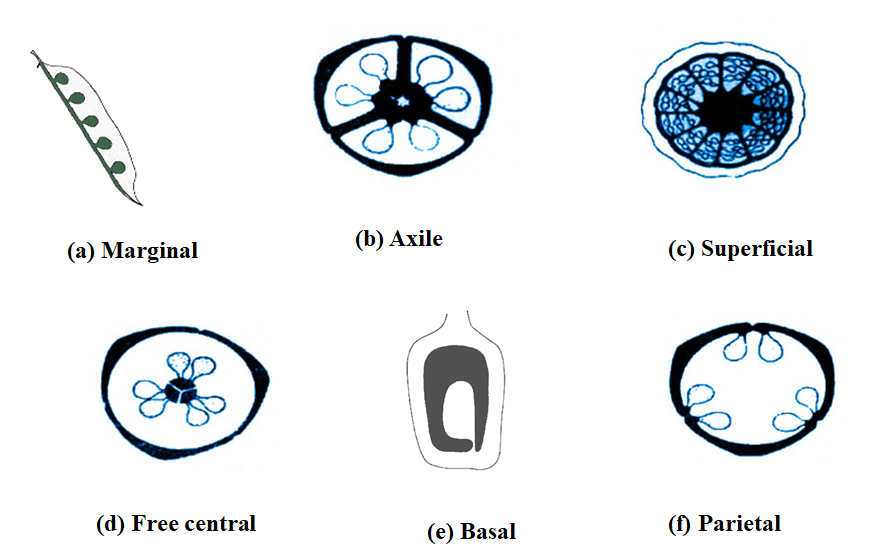
Define Placentation.
Answer
405.1k+ views
Hint: Inside the ovary, the developing embryo derives all its nutrition and basic amenities from the parent body, so it remains connected to the ovary.
Complete answer:
Placentation is defined as the arrangement of the placenta in the ovary of a flower. The placenta connects the ovules with the wall of the ovary.
The types of Placentation are-
1. Marginal placentation- In marginal placentation, the placenta forms a ridge along the ventral suture of the ovary and the ovules develop on it making two separate rows. This type of placentation is found in pea plants.
2. Parietal placentation- In parietal placentation, the ovules remain attached to the inner walls of the ovary. It is found in cucumber, etc.
3. Axile placentation- In axile placentation, the placenta lies on a central axis and ovules are attached to it. The ovary is segmented by fibrous septa. It is found in China rose, lemon, and tomato.
4. Basal placentation- In basal placentation, the placenta develops from its base and a single ovule is found attached to the base. It is found in the Asteraceae family that consists of marigold, sunflower, etc.
5. Free central placentation- In free central placentation, the ovules are present on the central axis. There is no formation of septa. This type of placentation is found in Dianthus and primrose.
Note:
1. The ovules inside a flower's ovary are attached via funiculi, the plant part equivalent to an umbilical cord in human beings. The part of the ovary where the funiculus attaches is known as the placenta.
2. Placentation is meant for the transfer of nutrients, respiratory gases, and water from maternal tissue to the growing embryo, and also for the removal of waste from the embryo.
3. Some plants have a special type of placentation known as Superficial placentation where the ovules develop over the entire inner surface of the carpels. It generally occurs in a multicarpellary ovary, e.g., Nymphaea.

Complete answer:
Placentation is defined as the arrangement of the placenta in the ovary of a flower. The placenta connects the ovules with the wall of the ovary.
The types of Placentation are-
1. Marginal placentation- In marginal placentation, the placenta forms a ridge along the ventral suture of the ovary and the ovules develop on it making two separate rows. This type of placentation is found in pea plants.
2. Parietal placentation- In parietal placentation, the ovules remain attached to the inner walls of the ovary. It is found in cucumber, etc.
3. Axile placentation- In axile placentation, the placenta lies on a central axis and ovules are attached to it. The ovary is segmented by fibrous septa. It is found in China rose, lemon, and tomato.
4. Basal placentation- In basal placentation, the placenta develops from its base and a single ovule is found attached to the base. It is found in the Asteraceae family that consists of marigold, sunflower, etc.
5. Free central placentation- In free central placentation, the ovules are present on the central axis. There is no formation of septa. This type of placentation is found in Dianthus and primrose.
Note:
1. The ovules inside a flower's ovary are attached via funiculi, the plant part equivalent to an umbilical cord in human beings. The part of the ovary where the funiculus attaches is known as the placenta.
2. Placentation is meant for the transfer of nutrients, respiratory gases, and water from maternal tissue to the growing embryo, and also for the removal of waste from the embryo.
3. Some plants have a special type of placentation known as Superficial placentation where the ovules develop over the entire inner surface of the carpels. It generally occurs in a multicarpellary ovary, e.g., Nymphaea.

Recently Updated Pages
Class 11 Question and Answer - Your Ultimate Solutions Guide

Master Class 11 English: Engaging Questions & Answers for Success

Master Class 11 Computer Science: Engaging Questions & Answers for Success

Master Class 11 Maths: Engaging Questions & Answers for Success

Master Class 11 Social Science: Engaging Questions & Answers for Success

Master Class 11 Economics: Engaging Questions & Answers for Success

Trending doubts
10 examples of friction in our daily life

What problem did Carter face when he reached the mummy class 11 english CBSE

Difference Between Prokaryotic Cells and Eukaryotic Cells

State and prove Bernoullis theorem class 11 physics CBSE

What organs are located on the left side of your body class 11 biology CBSE

Proton was discovered by A Thomson B Rutherford C Chadwick class 11 chemistry CBSE




